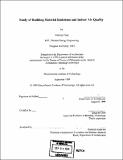| dc.contributor.advisor | Qingyan Chen. | en_US |
| dc.contributor.author | Yang, Xudong, 1966- | en_US |
| dc.contributor.other | Massachusetts Institute of Technology. Dept. of Architecture. | en_US |
| dc.date.accessioned | 2005-08-22T20:38:18Z | |
| dc.date.available | 2005-08-22T20:38:18Z | |
| dc.date.copyright | 1999 | en_US |
| dc.date.issued | 1999 | en_US |
| dc.identifier.uri | http://hdl.handle.net/1721.1/9366 | |
| dc.description | Thesis (Ph.D.)--Massachusetts Institute of Technology, Dept. of Architecture, 1999. | en_US |
| dc.description | Includes bibliographical references (leaves 201-210). | en_US |
| dc.description.abstract | Building materials and furnishings emit a wide variety of indoor pollutants, such as volatile organic compounds (VOCs). At present, no accurate models are available to characterize material emissions and sorption under realistic indoor conditions. The objective of this thesis is to fill that gap. Using the emission data measured in small-scale and full-scale environmental chambers, this investigation has developed a numerical model for simulating emissions of "wet" materials applied to porous substrates. This model considers VOC mass transfer processes in the air, material-air interface, material film, and the substrate. The model can predict "wet" material emissions under different environmental conditions (i.e., temperature, velocity, turbulence, and VOC concentration in the air) with reasonable accuracy. We developed two models for simulating VOC emissions from dry materials. One is a numerical model for short-term predictions, the other is an analytical model for long-term predictions. The models have been successfully used to examine the VOC emissions from two particleboard samples and a polypropene Styrene-Butadiene Rubber (SBR) carpet. A VOC sorption model has also been developed to analytically solve the VOC sorption rate as a function of air-phase concentrations. The model has been validated using an analytical solution as well as data obtained from sorption experiments. The emission and sorption models that we developed have been further used to study indoor air quality (IAQ) in a small office with different ventilation systems. The results show that displacement ventilation may not provide better IAQ than mixing systems if the VOC sources are from the floor. Further, our study shows sink effects from internal walls of gypsum board. | en_US |
| dc.description.statementofresponsibility | by Xudong Yang. | en_US |
| dc.format.extent | 217 leaves | en_US |
| dc.format.extent | 14478196 bytes | |
| dc.format.extent | 14477948 bytes | |
| dc.format.mimetype | application/pdf | |
| dc.format.mimetype | application/pdf | |
| dc.language.iso | eng | en_US |
| dc.publisher | Massachusetts Institute of Technology | en_US |
| dc.rights | M.I.T. theses are protected by copyright. They may be viewed from this source for any purpose, but reproduction or distribution in any format is prohibited without written permission. See provided URL for inquiries about permission. | en_US |
| dc.rights.uri | http://dspace.mit.edu/handle/1721.1/7582 | |
| dc.subject | Architecture. | en_US |
| dc.title | Study of building material emissions and indoor air quality | en_US |
| dc.type | Thesis | en_US |
| dc.description.degree | Ph.D. | en_US |
| dc.contributor.department | Massachusetts Institute of Technology. Department of Architecture | |
| dc.identifier.oclc | 44616316 | en_US |

